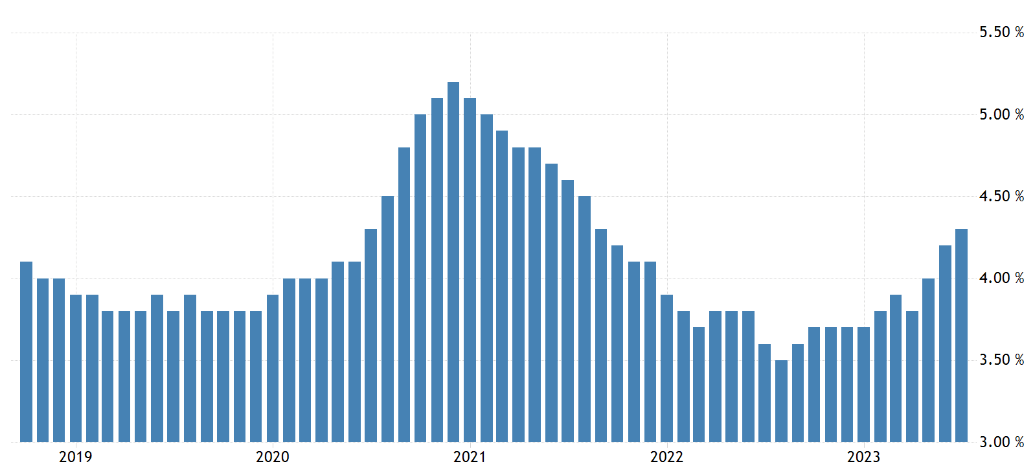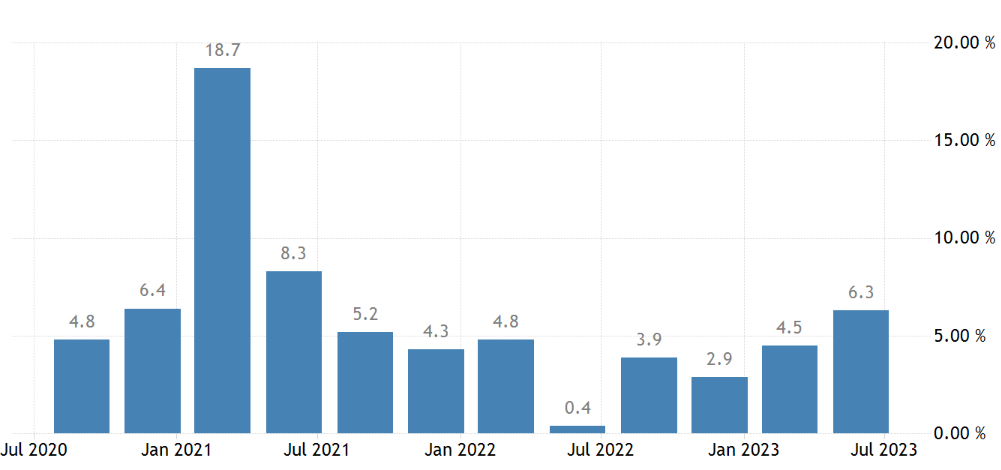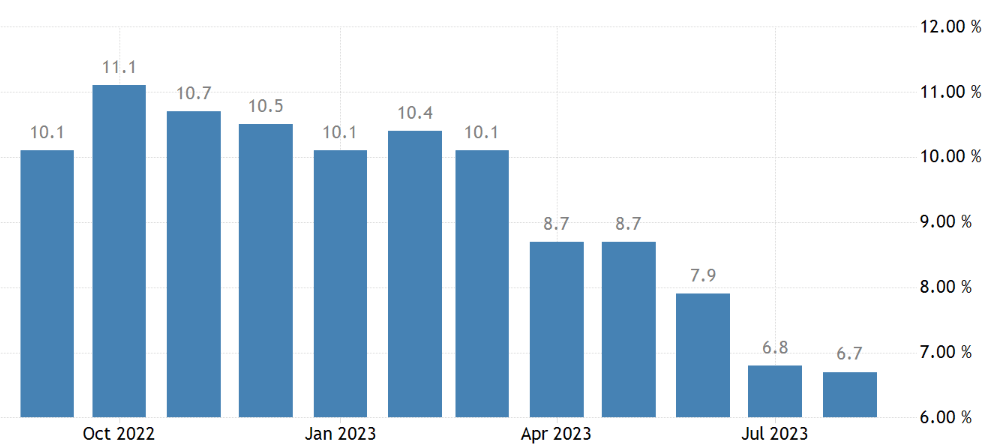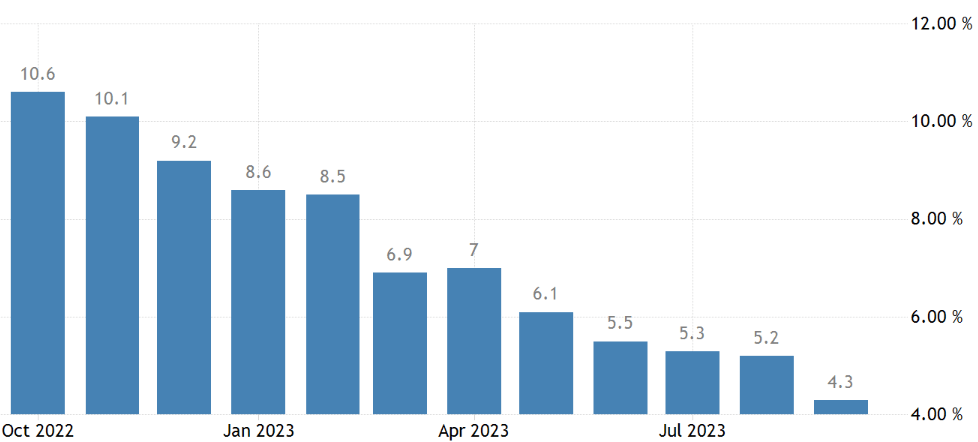Next week, as the third-quarter corporate earnings release season is in full sail, many noteworthy companies report their earnings to the public, only a part of which are mentioned in the article below. In addition, Wednesday will be a busy day as we follow the latest developments in the Chinese economy and get the latest inflation readings from the UK and the eurozone.
Table of Contents:
- UK Unemployment Rate (August)
- China Gross Domestic Product (GDP) YoY (Q3)
- UK Consumer Price Index (CPI) YoY (September)
- Eurozone Consumer Price Index (CPI) YoY (September)
- Stocks to watch
Tuesday 17.10. 06:00 GMT, UK Unemployment Rate (August)
The unemployment rate is the percentage of people without a job actively seeking employment in the previous month relative to the total number of people of working age or in the labour market. A high unemployment rate means that a large number of people are out of work despite actively seeking employment. A low unemployment rate indicates a stable labour market and greater availability of jobs.
Unemployment rates are important for economic analysis and can affect social and economic aspects. A high unemployment rate is associated with lower incomes and increased poverty, while a low unemployment rate promotes increased wages and social welfare. Governments and policymakers monitor the unemployment rate to assess the effectiveness of employment policies and take action to create jobs and support the unemployed. However, it should be remembered that the unemployment rate is one of many tools for assessing the labour market. Analysing other indicators, such as the labour force participation rate or wages, is also important.
From May to July 2023, the United Kingdom experienced a notable increase in its unemployment rate, reaching 4.3%. This rate was the highest recorded since the third quarter of 2021, suggesting a potential slowdown in the labour market. This shift followed several months of unprecedented monetary tightening by the Bank of England. The number of people out of work rose by 159,000 to a total of 1.46 million. This increase was mainly due to people who had been unemployed for up to 12 months.
During the same period, employment levels saw a substantial decline, with a decrease of 207 thousand people, bringing the total to 32.88 million. This drop was the most significant since the three months leading up to October 2020 and exceeded expectations, which had anticipated a decrease of 185 thousand. A reduction in the number of full-time self-employed workers primarily drove the decline.
Regarding wages, when excluding bonuses, there was a noteworthy increase of 7.8% compared to the previous year for the three months leading to July. This marked the most substantial wage growth since comparable records began in 2001. Furthermore, the overall growth in total pay reached 8.5%, surpassing the expected 8.2%. This, in part, may be due to the high inflation boosting the wage growth accordingly.

Source: Tradingeconomics.com
A higher-than-expected reading may have a bearish effect on the GBP, while a lower-than-expected reading could be bullish for the GBP.
Impact: GBP
Wednesday 18.10. 02:00 GMT, China Gross Domestic Product (GDP) YoY (Q3)
Gross domestic product (GDP) indicates the total value of goods and services produced in a country for a certain period. GDP is an important indicator of the health of an economy because it gives an overall picture of how well or poorly it is doing. If the GDP growth is higher than expected, the economy is in good shape and growing faster than expected. On the other hand, if the GDP growth is lower than expected, the economy performs weaker than anticipated.
In the second quarter, the Chinese economy expanded by 6.3% year-on-year. This was faster than the 4.5% recorded in the first quarter, but fell short of market expectations of 7.3% growth. It's important to note that the latest figures were affected by a low base of comparison from last year, when Shanghai and other major cities were under strict lockdown.
In the first half of the year, the Chinese economy grew by 5.5%. China had set a GDP growth target of around 5% for the year, following a 3% expansion in 2022. Beijing has been cautious about implementing significant stimulus measures, particularly in light of rising local government debt. Economic indicators in June showed a mixed picture, with retail sales rising at a slower pace while industrial output growth accelerated. The urban jobless rate remained stable at 5.2%, but youth unemployment reached a new high of 21.3%.
Previously released data indicated that China's exports experienced their most significant decline in three years. This decline was attributed to high inflation in key markets and geopolitical factors affecting foreign demand.

Source: Tradingeconomics.com
A higher-than-expected reading may have a bullish effect on the CNY, while a lower-than-expected reading could be bearish for the CNY.
Impact: CNY
Wednesday 18.10. 06:00 GMT, UK Consumer Price Index (CPI) YoY (September)
The CPI index measures changes in the prices of consumer goods and services. It covers different types of products, such as food, fuel, transportation services, cosmetics, household goods, clothing, and many others. The purpose of the CPI index is to measure the increase or decrease in the cost of living for consumers. As the CPI index rises, consumers' purchasing costs increase, affecting their money's purchasing power. The CPI index is used to monitor inflation or the overall rise in prices in the economy. It allows us to assess whether prices are rising too fast or too slowly and to determine what economic policy measures should be taken to offset the adverse effects of inflation.
In August 2023, consumer price inflation in the United Kingdom showed a slight decrease, falling to 6.7% from the previous month's 6.8%. This figure came in below the market's anticipated rate of 7.0%, marking the lowest rate since February 2022. The reduction could be attributed primarily to a deceleration in food price inflation and a decrease in the cost of accommodation services. Moreover, the core inflation rate, which excludes volatile items such as energy and food, dipped to 6.2%, the lowest level since March, significantly lower than the expected rate of 6.8%.
Various categories experienced softer price increases: food and non-alcoholic beverages (13.6% compared to 14.8% in July); furniture, household equipment, and maintenance (5.1% compared to 6.2%); recreation and culture (5.8% compared to 6.5%); restaurants and hotels (8.3% compared to 9.6%); and miscellaneous goods and services (5.6% compared to 6.0%). Meanwhile, transport prices saw a milder decline of 0.5%, in contrast to the 2.0% drop observed in July. It was due to a monthly rise in motor fuel costs, driven by the increasing global oil prices. On a monthly basis, the Consumer Price Index (CPI) increased by 0.3% in August.

Source: Tradingeconomics.com
If the reading is higher than expected, inflation is higher, possibly favouring a fall in the GBP. Meanwhile, it is also a stimulus for the BoE to raise interest rates and reduce the money supply, causing an increase in the GBP. If the reading is lower than expected, it may give the BoE an argument to stop its policy of raising interest rates.
Impact: GBP, FTSE 100 and other indices
Wednesday 18.10. 09:00 GMT, Eurozone Consumer Price Index (CPI) YoY (September)
In September 2023, the inflation rate in the eurozone declined to 4.3% year-on-year, marking its lowest level since October 2021 and falling below the market consensus of 4.5%, according to a preliminary estimate. Prices showed a slower increase in several categories: services (4.7% compared to 5.5% in August), non-energy industrial goods (4.2% compared to 4.7%), and food, alcohol, and tobacco (8.8% compared to 9.7%). Simultaneously, the deflation in energy costs deepened, with a rate of -4.7% compared to -3.3%. The core inflation rate, a critical underlying measure that excludes volatile food and energy prices, also cooled to 4.5% in September, reaching its lowest point since August 2022.
Among the largest economies within the eurozone, HICP rates decreased in Germany (4.3% compared to 6.4%), France (5.6% compared to 5.7%), and the Netherlands (-0.3% compared to 3.4%). However, in Italy and Spain, inflation rates accelerated to 5.7% and 3.2% from 5.5% and 2.4%, respectively.

Source: Tradingeconomics.com
If the reading is higher than expected, inflation is higher, possibly favouring a fall in the EUR. Meanwhile, it is also a stimulus for the ECB to raise interest rates and reduce the money supply, causing an increase in the EUR. If the reading is lower than expected, it may give the ECB an argument to stop its policy of raising interest rates.
Impact: EUR, DAX, STOXX and other indices
Stocks to watch
J&J (JNJ) announcing its earnings results for the quarter ending on 09/2023. Forecast EPS: 2.52. Positive earnings surprise in 10 out of the last 10 reports. Time: Tuesday, October 17, before the market opens.
Tesla (TSLA) announcing its earnings results for the quarter ending on 09/2023. Forecast EPS: 0.7511. Positive earnings surprise in 4 out of the last 10 reports. Time: Wednesday, October 18, after the market closes.
Netflix (NFLX) announcing its earnings results for the quarter ending on 09/2023. Forecast EPS: 3.51. Positive earnings surprise in 8 out of the last 10 reports. Time: Wednesday, October 18, after the market closes.
Philip Morris (PM) announcing its earnings results for the quarter ending on 09/2023. Forecast EPS: 1.61. Positive earnings surprise in 9 out of the last 10 reports. Time: Thursday, October 19, before the market opens.
AT&T (T) announcing its earnings results for the quarter ending on 09/2023. Forecast EPS: 0.6221. Positive earnings surprise in 9 out of the last 10 reports. Time: Thursday, October 19, before the market opens.
American Express (AXP) announcing its earnings results for the quarter ending on 09/2023. Forecast EPS: 2.95. Positive earnings surprise in 8 out of the last 10 reports. Time: Friday, October 20, before the market opens.
Santa Zvaigzne-Sproge, CFA, Head of Investment Advice Department at Conotoxia Ltd. (Conotoxia investment service)
Materials, analysis, and opinions contained, referenced, or provided herein are intended solely for informational and educational purposes. The personal opinion of the author does not represent and should not be constructed as a statement, or investment advice made by Conotoxia Ltd. All indiscriminate reliance on illustrative or informational materials may lead to losses. Past performance is not a reliable indicator of future results.
CFDs are complex instruments and come with a high risk of losing money rapidly due to leverage. 72.95% of retail investor accounts lose money when trading CFDs with this provider. You should consider whether you understand how CFDs work and whether you can afford to take the high risk of losing your money.


